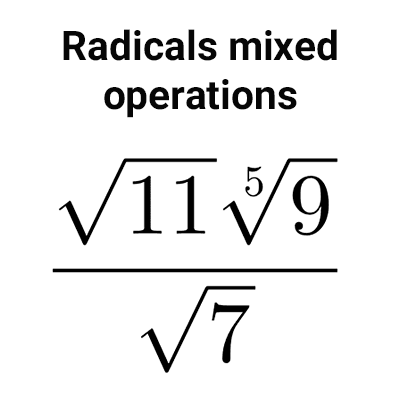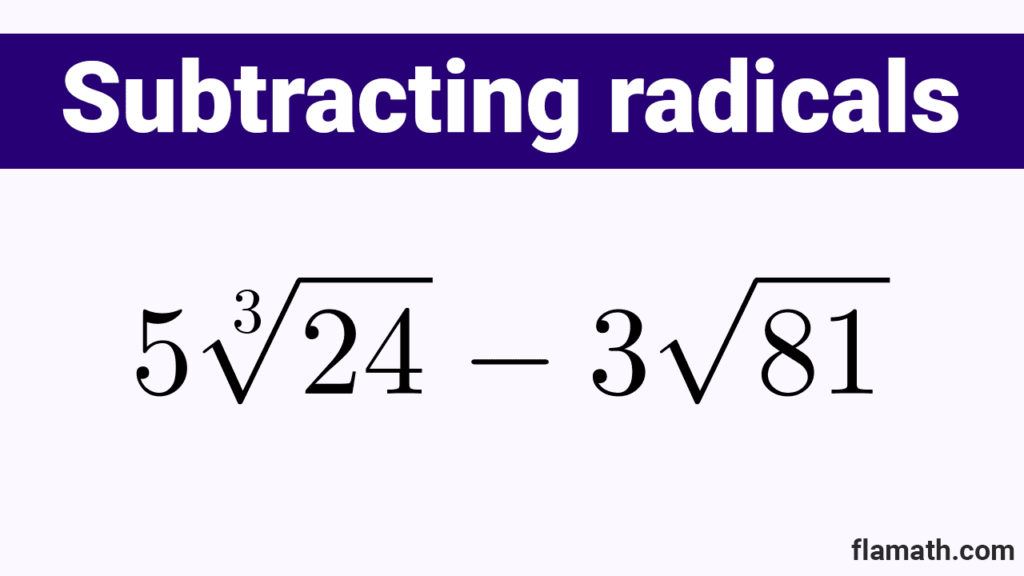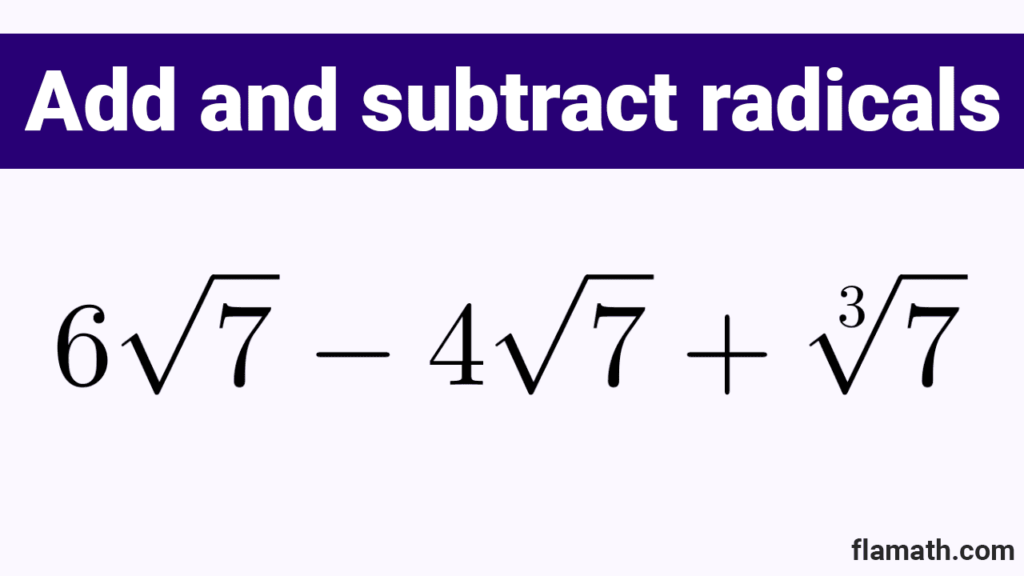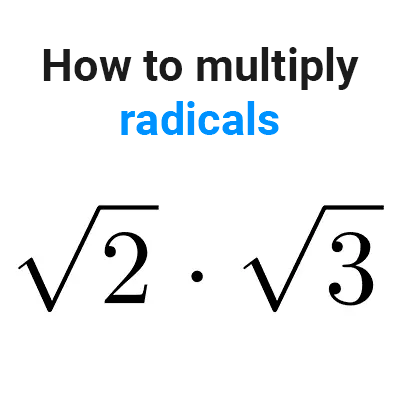
Adding and subtracting radicals
In this article we explain how to solve the addition and subtraction of radicals, that is, expressions with square, cubic or any index roots. We will see the step by step with solved exercises.
Table of Contents
Addition and subtraction of like radicals
Before explaining the addition and subtraction of radicals, it is important to recall important concepts about them.
Two radicals are like (equal) if they have the same index and the same radicand. At first glance, they look the same.
For example, in the expression *2\sqrt{8}+5\sqrt{8}*, the radicals that appear are alike. The number multiplying the radical is called the coefficient. In this example, the coefficients are *2* and *5.*
In the expression *8\sqrt{6}-2\sqrt[3]{6}*, there are no like radicals because, even though they have the same radicand (what appears inside the root), the indices are different.
If we have a sum of radical expressions, and they are alike, as in *2\sqrt{8}+5\sqrt{8}*, we can consider extracting the common factor as the radical. In this way, *\sqrt{8}* is the common factor, and the equivalent expression is: *2\sqrt{8}+5\sqrt{8}=(2+5)\sqrt{8}.* Generalizing this reasoning, we find a formula for adding like roots.
To add or subtract like radicals, add the coefficients of the radicals and maintain the same radical.
*a\sqrt[n]{k}+b \sqrt[n]{k}=(a+b) \sqrt[n]{k}*
Example 1
*2\sqrt{3}+5\sqrt{3}*
In this case, we have the sum of square roots with equal radicands. Following the formula, add the coefficients and keep the same root:
*2\sqrt{3}+5\sqrt{3}=(2+5)\sqrt{3}=7\sqrt{3}*
An easy way to understand it is: if we have two times something and five times that same something, in total, we have seven times that something.
Example 2
*6\sqrt{7}-4\sqrt{7}+\sqrt[3]{7}*
In the expression, we identify that the square root of seven appears twice, and the cube root of seven appears once. Although the latter root has the same radicand as the others, it is not enough to be like them because the indices are different. In this case, add the like radicals, and the other is left as it is.
*6\sqrt{7}-4\sqrt{7}+\sqrt[3]{7}=(6-4)\sqrt{7}+\sqrt[3]{7}=2\sqrt{7}+\sqrt[3]{7}*
Example 3
*\sqrt[3]{6}-3\sqrt[4]{5}+7\sqrt[3]{6}+8\sqrt[4]{5}*
In this expression, we can identify two pairs of like radicals: the cube roots of six and the fourth roots of five. To solve this operation, add each radical with its like counterpart.
*\sqrt[3]{6}-3\sqrt[4]{5}+7\sqrt[3]{6}+8\sqrt[4]{5}=(1+7)\sqrt[3]{6}+(-3+8)\sqrt[4]{5}*
*=8\sqrt[3]{6}+5\sqrt[4]{5}*
Example 4
The coefficients of the radicals can be fractions; in such cases, when adding or subtracting, follow the rules of these numbers.
*\dfrac{7}{4}\sqrt{11}+\dfrac{6\sqrt{11}}{5}=\left(\dfrac{7}{4}+\dfrac{6}{5}\right)\sqrt{11}*
*=\dfrac{59}{20}\sqrt{11}*
Example 5
If variables (letters) appear in the radicand or coefficients, operate in the same way as before. Here, we see two cases:
*(x+1)\sqrt{3}+26\sqrt{3}=(x+1+26)\sqrt{3}=(x+27)\sqrt{3}*
*a\sqrt{x+7}+2a\sqrt{x+7}=(a+2a)\sqrt{x+7}=3a\sqrt{x+7}*
Practice exercises: solve the following operations.
- *-5\sqrt[7]{9}-20\sqrt[7]{9}*
- *\dfrac{\sqrt[3]{20}}{4}-\dfrac{\sqrt[3]{20}}{17}*
- *6\sqrt{12}+7\sqrt{12}-\sqrt{12}*
- *4\sqrt[3]{2}-6\sqrt[3]{2}+20\sqrt[3]{2}-5\sqrt[3]{2}*
- *-8\sqrt[4]{3}+8\sqrt[3]{4}-5\sqrt[4]{3}*
Solutions:
- *-5\sqrt[7]{9}-20\sqrt[7]{9}=(-5-20)\sqrt[7]{9}=-25\sqrt[7]{9}*
- *\dfrac{\sqrt[3]{20}}{4}-\dfrac{\sqrt[3]{20}}{17}=\left(\dfrac{1}{4}-\dfrac{1}{17}\right)\sqrt[3]{20}=\dfrac{13}{6}\sqrt[3]{20}*
- *6\sqrt{12}+7\sqrt{12}-\sqrt{12}=(6+12-1)\sqrt{12}=17\sqrt{12}*
- *4\sqrt[3]{2}-6\sqrt[3]{2}+20\sqrt[3]{2}-5\sqrt[3]{2}=(4-6+20-5)\sqrt[3]{2}=13\sqrt[3]{2}*
- *-8\sqrt[4]{3}+8\sqrt[3]{4}-5\sqrt[4]{3}=(-8-5)\sqrt[4]{3}+8\sqrt[3]{4}=-13\sqrt[4]{3}+8\sqrt[3]{4}*
Addition and subtraction of unlike radicals
Sometimes, two radicals that are not alike can become so through appropriate simplification. For example, at first glance, in the operation *9\sqrt{3}+\sqrt{75}*, there are no like radicals, but the second term can be rewritten following these steps:
- Factorize the radicand: *75=5^2\cdot 3*
- Write it inside the radical symbol and simplify using the property of roots: *\sqrt{75}=\sqrt{5^2\cdot 3}=\sqrt{5^2}\sqrt{3}=5\sqrt{3}*
- Replace it in the original expression: *9\sqrt{3}+{\color{green}5\sqrt{3}},* which now has like radicals that can be operated on as seen earlier, resulting in *14\sqrt{3}*
To add or subtract unlike radicals, try to simplify them to make them alike. If this is not possible, leave the sum or difference as is.
There are useful properties to consider in simplifications, which we will see below.
If the index and exponent of a root are both multiplied or divided by the same positive integer, the new root obtained is equivalent to the original.
*\sqrt[n]{a}=\sqrt[n\cdot k]{a^k}*
For example, by multiplying the exponent and index by 2 in *\sqrt{2}*, we get *\sqrt[2\cdot 2]{2^2}=\sqrt[4]{4},* which is equivalent to the original square root.
Sometimes, a more convenient way to work with radicals is to think of them as numbers with fractional exponents, according to the following property.
Radicands are a different way of writing fractional exponents.
*\sqrt[n]{a}=a^\frac{1}{n}*
*\sqrt[n]{a^k}=a^\frac{k}{n}*
So, for example, *\sqrt{2}* is the same as writing *2^\frac{1}{2}.* When thinking in terms of exponents, all their laws apply. Thus, the previous property is understood as multiplying the fractional exponent by a fraction that equals 1.
In our example, *\sqrt{2}* was equal to *\sqrt[4]{4}.* If we write it in exponent form, we see why this happens:
*\sqrt[4]{4}=\sqrt[4]{2^2}=2^\frac{2}{4}=2^\frac{1}{2}=\sqrt{2}*
Similarly, we can go from *\sqrt{2}* to *\sqrt[4]{4}* by multiplying the exponent by *\dfrac{2}{2},* which is equal to multiplying by 1, so the value does not change.
*\sqrt{2}=2^\frac{1}{2}=2^{\frac{1}{2}\cdot {\color{green}\frac{2}{2}}}=2^\frac{2}{4}=\sqrt[4]{2^2}=\sqrt[4]{4}*
Knowing these properties will help us simplify expressions to achieve similar radicals. We will now look at three cases that may arise when trying to add or subtract radicals that are not similar at first glance.
Case 1: Radicals with equal index and different radicands
If the roots have the same index but different radicands, the key is to factorize the latter into prime factors and leave only those inside the root that are convenient.
Example 1: *6\sqrt{63}+4\sqrt{7}*
The *63* can be factorized as *63=3^2\cdot 7.* The root becomes *\sqrt{63}=\sqrt{3^2 \cdot 7}=\sqrt{3^2}\sqrt{7}=3\sqrt{7}*
Now, replacing in the original expression:
*6{\color{green}\sqrt{63}}+4\sqrt{7}=6\cdot {\color{green}3\sqrt{7}}+4\sqrt{7}*
*=18\sqrt{7}+4\sqrt{7}*
*=22\sqrt{7}*
Example 2: *5\sqrt[3]{24}-3\sqrt{81}*
Here we need to factorize both radicands. We do it inside the roots for convenience.
*\sqrt[3]{24}=\sqrt[3]{2^3\cdot 3}=\sqrt[3]{2^3}\sqrt{3}=2\sqrt[3]{3}*
*\sqrt[3]{81}=\sqrt[3]{3^4}=\sqrt[3]{3^3\cdot 3}=\sqrt[3]{3^3}\sqrt[3]{3}=3\sqrt[3]{3}*
Note that in the second root, we use the property of the product of powers with the same base in reverse to write *3^4* conveniently and cancel the cubic root.
Now, replacing in the original expression:
*5{\color{green}\sqrt[3]{24}}-3{\color{purple}\sqrt{81}}=5\cdot {\color{green}2\sqrt[3]{3}} -3\cdot {\color{purple}3\sqrt[3]{3}}*
*=10\sqrt[3]{3}-9\sqrt[3]{3}*
*=\sqrt[3]{3}*
Example 3: *10\sqrt{140}-\sqrt{315}*
We factorize and simplify:
*\sqrt{140}=\sqrt{2^2\cdot 5\cdot 7}=\sqrt{2^2}\sqrt{5\cdot 7}=2\sqrt{35}*
*\sqrt{315}=\sqrt{3^2\cdot 5\cdot 7}=\sqrt{3^2}\sqrt{5\cdot 7}=3\sqrt{35}*
Now, replacing and solving:
*10{\color{green}\sqrt{140}}-{\color{purple}\sqrt{315}}=10\cdot {\color{green}2\sqrt{35}}-{\color{purple}3\sqrt{35}}*
*=20\sqrt{35}-3\sqrt{35}*
*=17\sqrt{35}*
Case 2: Radicals with different index and radicand
If the roots do not have the same index or radicand, similar roots can be achieved by factorizing the radicand and simplifying. It is useful to express the roots as exponents.
Example 1: *\sqrt{2}+\sqrt[6]{8}*
At first glance, it doesn't seem operable. However, in the second root, *8* can be written as *2^3*, and then the exponent expression can be used to simplify it.
*\sqrt[6]{8}=\sqrt[6]{2^3}=2^\frac{3}{6}=2^\frac{1}{2}=\sqrt{2}*
Now we replace in the original expression and solve:
*\sqrt{2}+\sqrt[6]{8}=\sqrt{2}+\sqrt{2}=2\sqrt{2}*
Example 2: *\sqrt[9]{343}-5\sqrt[6]{49}*
We factorize the radicand and express the root as an exponent to simplify:
*\sqrt[9]{343}=\sqrt[9]{7^3}=7^\frac{3}{9}=7^\frac{1}{3}=\sqrt[3]{7}*
*\sqrt[6]{49}=\sqrt[6]{7^2}=7^\frac{2}{6}=7^\frac{1}{3}=\sqrt[3]{7}*
Now, we replace and solve:
*\sqrt[9]{343}-5\sqrt[6]{49}=\sqrt[3]{7}-5\sqrt[3]{7}=-4\sqrt[3]{7}*
Example 3: *2\sqrt[8]{81}-6\sqrt[4]{144}*
*\sqrt[8]{81}=\sqrt[8]{3^4}=3^\frac{4}{8}=3^\frac{1}{2}=\sqrt{3}*
*\sqrt[4]{144}=\sqrt[4]{2^4\cdot 3^2}=(2^4\cdot 3^2)^\frac{1}{4}=2^\frac{4}{4}\cdot 3^\frac{2}{4}=2\cdot 3^\frac{1}{2}=2\sqrt{3}*
We replace in the original expression and solve:
*2\sqrt[8]{81}-6\sqrt[4]{144}=2\sqrt{3}-6\cdot (2\sqrt{3})*
*=2\sqrt{3}-12\sqrt{3}*
*=-10\sqrt{3}*
Case 3: Radicals with equal radicand and different index
If two radicals have the same radicand but different index, the sum or difference remains unchanged.
For example, *\sqrt{2}+\sqrt[3]{2}* cannot be further operated on and is written as is.
Practice exercises
Exercise: solve the following additions and subtractions of radicals.
- *\sqrt{16}+\sqrt{8}*
- *\sqrt{27}+\sqrt{243}*
- *\sqrt{72}-\sqrt{36}*
- *10\sqrt{5}+\sqrt{125}*
- *9\sqrt{10}-2\sqrt{3}+5\sqrt{10}-4\sqrt{3}*
- *10\sqrt[3]{2}-(\sqrt[3]{2}+8\sqrt[3]{2})+\sqrt[3]{2}*
- *3\sqrt{8}+2\sqrt{18}+2\sqrt{2}-3\sqrt{3}*
- *\sqrt{75}-2\sqrt{12}-7\sqrt{3}+\sqrt{27}*
- *\sqrt{2}+\sqrt{3}+\sqrt{12}-\sqrt{32}*
- *\sqrt{16}-\sqrt{25}-\sqrt{9}*
Solutions:
- *\sqrt{16}+\sqrt{8}=4+\sqrt{2^3}=4+\sqrt{2^2\cdot 2}=4+2\sqrt{2}=4+2\sqrt{2}*
- *\sqrt{27}+\sqrt{243}=\sqrt{3^3}+\sqrt{3^5}=\sqrt{3^2\cdot 3}+\sqrt{3^4\cdot 3}=3\sqrt{3}+3^2\sqrt{3}=12\sqrt{3}*
- *\sqrt{72}-\sqrt{36}=\sqrt{3^2\cdot 2^3}-6=\sqrt{3^2\cdot 2^2\cdot 2}-6=3\cdot 2\sqrt{2}-6=6\sqrt{2}-6*
- *10\sqrt{5}+\sqrt{125}=10\sqrt{5}+\sqrt{5^3}=10\sqrt{5}+\sqrt{5^2\cdot 5}=10\sqrt{5}+5\sqrt{5}=15\sqrt{5}*
- *9\sqrt{10}-2\sqrt{3}+5\sqrt{10}-4\sqrt{3}=14\sqrt{10}-6\sqrt{3}*
- *10\sqrt[3]{2}-(\sqrt[3]{2}+8\sqrt[3]{2}+\sqrt[3]{2}=10\sqrt[3]{2}-9\sqrt[3]{2}+\sqrt[3]{2}=2\sqrt[3]{2}*
- *3\sqrt{8}+2\sqrt{18}+2\sqrt{2}-3\sqrt{3}=3\sqrt{2^2\cdot 2}+2\sqrt{3^2\cdot 2}+2\sqrt{2}-3\sqrt{3}=3\cdot 2\sqrt{2}+2\cdot 3\sqrt{2}+2\sqrt{2}-3\sqrt{3}=14\sqrt{2}-3\sqrt{3}*
- *\sqrt{75}-2\sqrt{12}-7\sqrt{3}+\sqrt{27}=\sqrt{3^2\cdot 5}-2\sqrt{2^2\cdot 3}-7\sqrt{3}+\sqrt{3^2\cdot 3}=3\sqrt{5}-2\cdot 2\sqrt{3}-7\sqrt{3}+3\sqrt{3}=3\sqrt{5}-8\sqrt{3}*
- *\sqrt{2}+\sqrt{3}+\sqrt{12}-\sqrt{32}=\sqrt{2}+\sqrt{3}+\sqrt{2^2\cdot 3}-\sqrt{2^4\cdot 2}=\sqrt{2}+\sqrt{3}+2\sqrt{3}-4\sqrt{2}=-3\sqrt{2}+3\sqrt{3}*
- *\sqrt{16}-\sqrt{25}-\sqrt{9}=4-5-3=-4*
FAQs
How to add or subtract radicals?
To add radicals, we must first make sure that they are similar, that is, that they have the same index and the same radicand. To add them we simply add the coefficients and keep the same radical. If the radicals are not similar, you can try to rewrite them so that they are.
How to add square roots?
To be able to add square roots both must have the same radicand, if they do not have it, you must try to rewrite them so that they have it. To add them, add the coefficients and keep the same root.
How to add roots of different index?
To add roots of different indexes, they must be rewritten so that they have the same index and the same radicand. This can be achieved by factoring, simplifying or using the properties of roots.





Other articles that may interest you